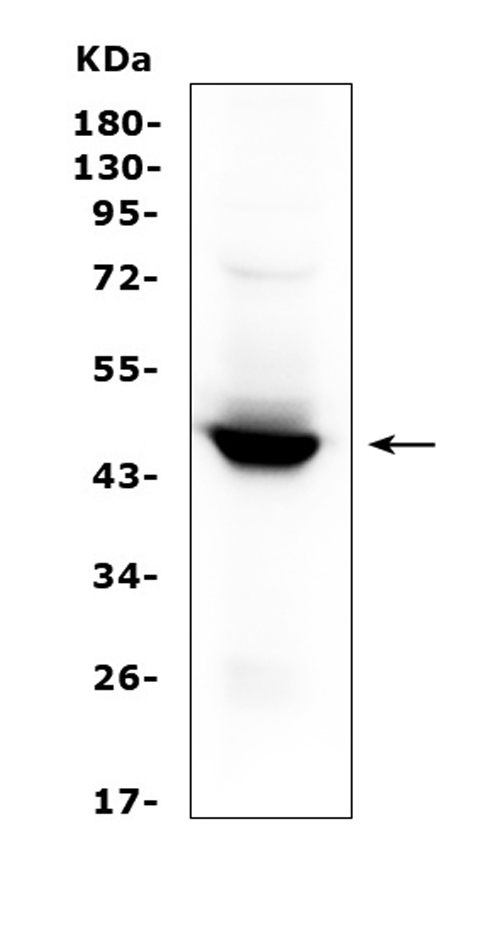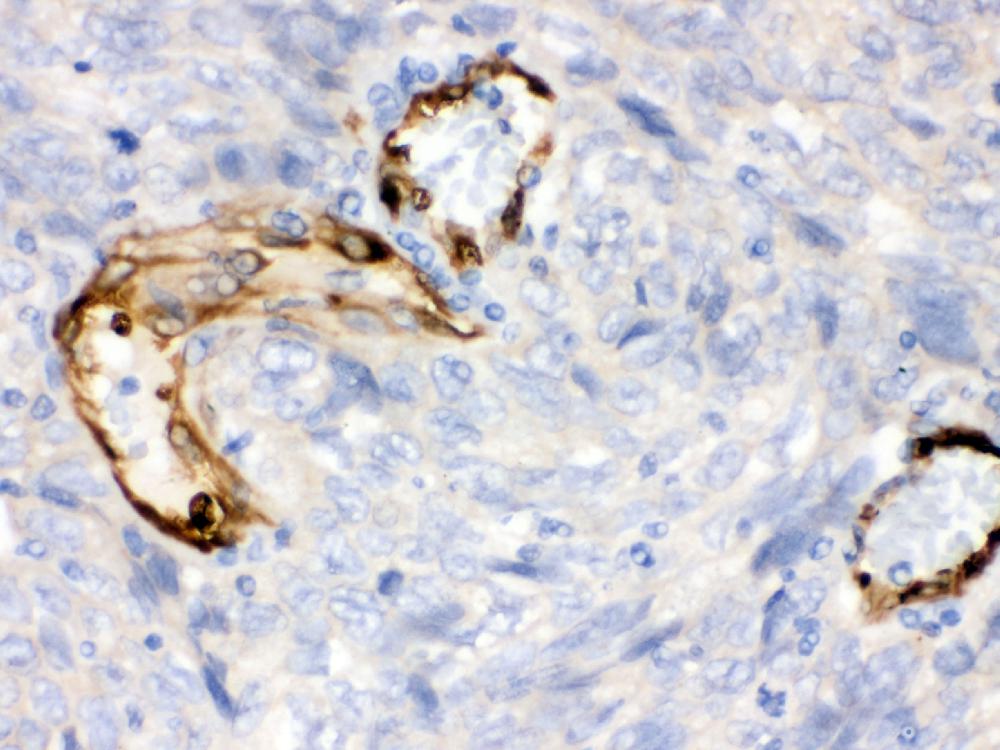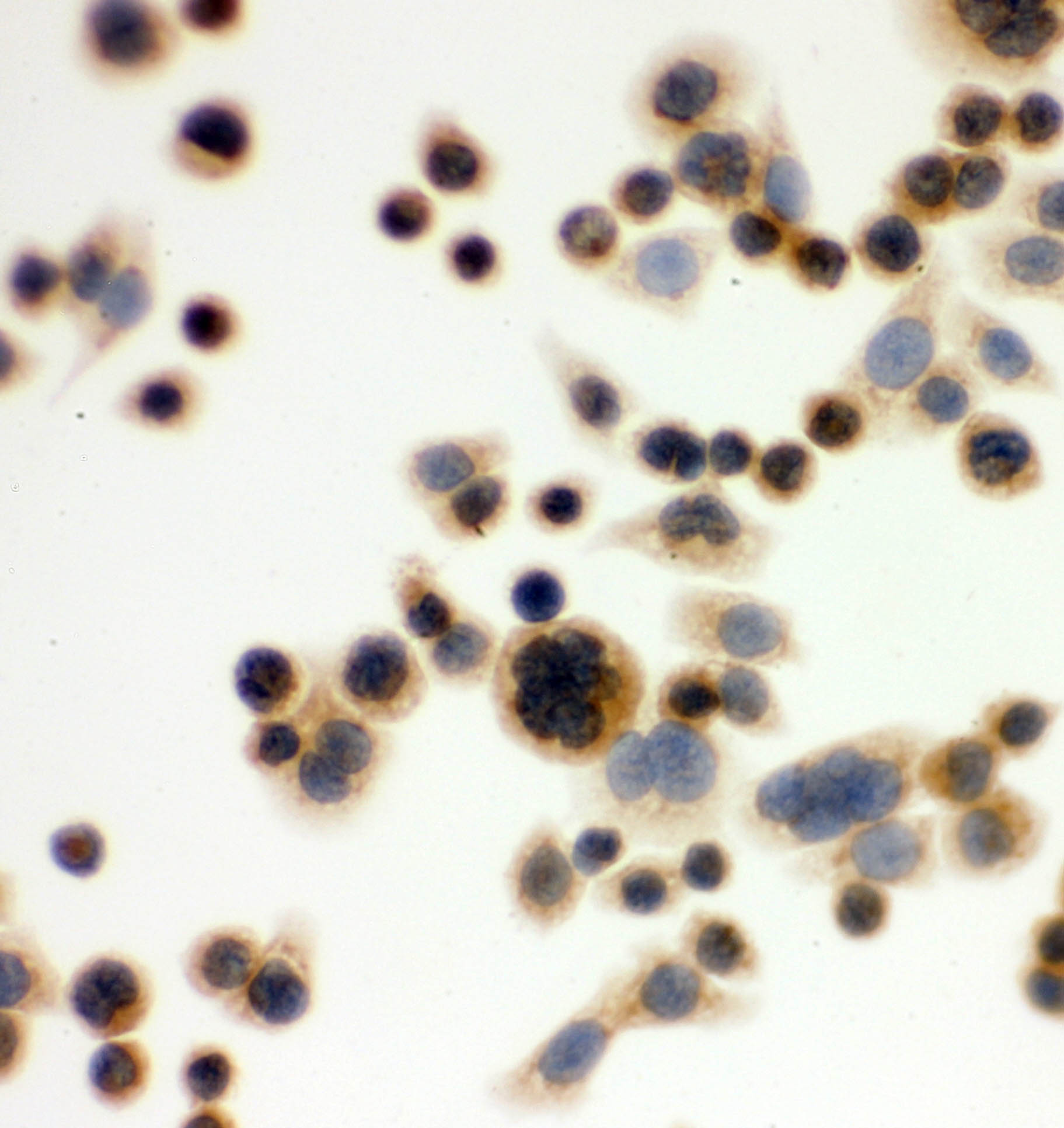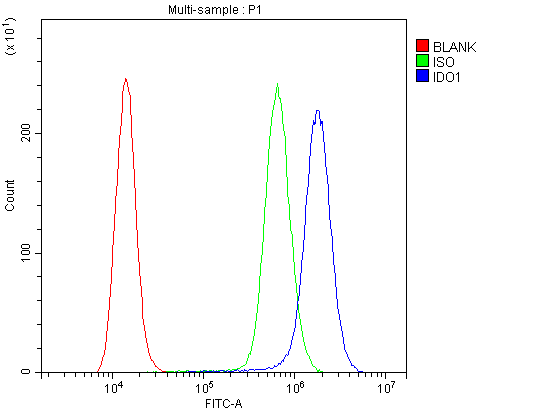| Western blot (WB): | 1:500-2000 |
| Immunohistochemistry (IHC): | 1:50-400 |
| Immunocytochemistry/Immunofluorescence (ICC/IF): | 1:50-400 |
| Flow Cytometry (Fixed): | 1:50-200 |
| (Boiling the paraffin sections in 10mM citrate buffer,pH6.0,or PH8.0 EDTA repair liquid for 20 mins is required for the staining of formalin/paraffin sections.) Optimal working dilutions must be determined by end user. | |

Figure 1. Western blot analysis of IDO1 using anti- IDO1 antibody (PB9603).
Electrophoresis was performed on a 5-20% SDS-PAGE gel at 70V (Stacking gel) / 90V (Resolving gel) for 2-3 hours. The sample well of each lane was loaded with 50ug of sample under reducing conditions.
Lane 1: human placenta tissue lysates.
After Electrophoresis, proteins were transferred to a Nitrocellulose membrane at 150mA for 50-90 minutes. Blocked the membrane with 5% Non-fat Milk/ TBS for 1.5 hour at RT. The membrane was incubated with rabbit anti- IDO1 antigen affinity purified polyclonal antibody (Catalog # PB9603) at 0.5 μg/mL overnight at 4°C, then washed with TBS-0.1%Tween 3 times with 5 minutes each and probed with a goat anti-rabbit IgG-HRP secondary antibody at a dilution of 1:10000 for 1.5 hour at RT. The signal is developed using an Enhanced Chemiluminescent detection (ECL) kit (Catalog # EK1002) with Tanon 5200 system. A specific band was detected for IDO1 at approximately 45KD. The expected band size for IDO1 is at 45KD.

Figure 2. IHC analysis of IDO1 using anti-IDO1 antibody (PB9603).
IDO1 was detected in paraffin-embedded section of Human Lung Cancer Tissue. Heat mediated antigen retrieval was performed in citrate buffer (pH6, epitope retrieval solution) for 20 mins. The tissue section was blocked with 10% goat serum. The tissue section was then incubated with 1μg/ml rabbit anti-IDO1 Antibody (PB9603) overnight at 4°C. Biotinylated goat anti-rabbit IgG was used as secondary antibody and incubated for 30 minutes at 37°C. The tissue section was developed using Strepavidin-Biotin-Complex (SABC)(Catalog # SA1022) with DAB as the chromogen.

Figure 3. IHC analysis of IDO1 using anti-IDO1 antibody (PB9603).
IDO1 was detected in immunocytochemical section of SW480 cell. Enzyme antigen retrieval was performed using IHC enzyme antigen retrieval reagent (AR0022) for 15 mins. The cells were blocked with 10% goat serum. And then incubated with 1μg/ml rabbit anti-IDO1 Antibody (PB9603) overnight at 4°C. Biotinylated goat anti-rabbit IgG was used as secondary antibody and incubated for 30 minutes at 37°C. The section was developed using Strepavidin-Biotin-Complex (SABC)(Catalog # SA1022) with DAB as the chromogen.

Figure 4. Flow Cytometry analysis of A431 cells using anti-IDO1 antibody (PB9603).
Overlay histogram showing A431 cells stained with PB9603 (Blue line).The cells were blocked with 10% normal goat serum. And then incubated with rabbit anti-IDO1 Antibody (PB9603, 1:100) for 30 min at 20°C. DyLight488 conjugated goat anti-rabbit IgG (BA1127, 1:100) was used as secondary antibody for 30 minutes at 20°C. Isotype control antibody (Green line) was rabbit IgG (1:100) used under the same conditions. Unlabelled sample (Red line) was also used as a control.

Figure 5. ICC analysis using anti-IDO1 antibody (PB9603) was detected in immersion fixed A431 cell line . Cells were stained using the Dylight488-conjugated Anti-rabbit IgG Secondary Antibody (green)(Catalog?#?BA1127) and counterstained with DAPI (blue).

Figure 1. Western blot analysis of IDO1 using anti- IDO1 antibody (PB9603).
Electrophoresis was performed on a 5-20% SDS-PAGE gel at 70V (Stacking gel) / 90V (Resolving gel) for 2-3 hours. The sample well of each lane was loaded with 50ug of sample under reducing conditions.
Lane 1: human placenta tissue lysates.
After Electrophoresis, proteins were transferred to a Nitrocellulose membrane at 150mA for 50-90 minutes. Blocked the membrane with 5% Non-fat Milk/ TBS for 1.5 hour at RT. The membrane was incubated with rabbit anti- IDO1 antigen affinity purified polyclonal antibody (Catalog # PB9603) at 0.5 μg/mL overnight at 4°C, then washed with TBS-0.1%Tween 3 times with 5 minutes each and probed with a goat anti-rabbit IgG-HRP secondary antibody at a dilution of 1:10000 for 1.5 hour at RT. The signal is developed using an Enhanced Chemiluminescent detection (ECL) kit (Catalog # EK1002) with Tanon 5200 system. A specific band was detected for IDO1 at approximately 45KD. The expected band size for IDO1 is at 45KD.

Figure 2. IHC analysis of IDO1 using anti-IDO1 antibody (PB9603).
IDO1 was detected in paraffin-embedded section of Human Lung Cancer Tissue. Heat mediated antigen retrieval was performed in citrate buffer (pH6, epitope retrieval solution) for 20 mins. The tissue section was blocked with 10% goat serum. The tissue section was then incubated with 1μg/ml rabbit anti-IDO1 Antibody (PB9603) overnight at 4°C. Biotinylated goat anti-rabbit IgG was used as secondary antibody and incubated for 30 minutes at 37°C. The tissue section was developed using Strepavidin-Biotin-Complex (SABC)(Catalog # SA1022) with DAB as the chromogen.

Figure 3. IHC analysis of IDO1 using anti-IDO1 antibody (PB9603).
IDO1 was detected in immunocytochemical section of SW480 cell. Enzyme antigen retrieval was performed using IHC enzyme antigen retrieval reagent (AR0022) for 15 mins. The cells were blocked with 10% goat serum. And then incubated with 1μg/ml rabbit anti-IDO1 Antibody (PB9603) overnight at 4°C. Biotinylated goat anti-rabbit IgG was used as secondary antibody and incubated for 30 minutes at 37°C. The section was developed using Strepavidin-Biotin-Complex (SABC)(Catalog # SA1022) with DAB as the chromogen.

Figure 4. Flow Cytometry analysis of A431 cells using anti-IDO1 antibody (PB9603).
Overlay histogram showing A431 cells stained with PB9603 (Blue line).The cells were blocked with 10% normal goat serum. And then incubated with rabbit anti-IDO1 Antibody (PB9603, 1:100) for 30 min at 20°C. DyLight488 conjugated goat anti-rabbit IgG (BA1127, 1:100) was used as secondary antibody for 30 minutes at 20°C. Isotype control antibody (Green line) was rabbit IgG (1:100) used under the same conditions. Unlabelled sample (Red line) was also used as a control.

Figure 5. ICC analysis using anti-IDO1 antibody (PB9603) was detected in immersion fixed A431 cell line . Cells were stained using the Dylight488-conjugated Anti-rabbit IgG Secondary Antibody (green)(Catalog?#?BA1127) and counterstained with DAPI (blue).




